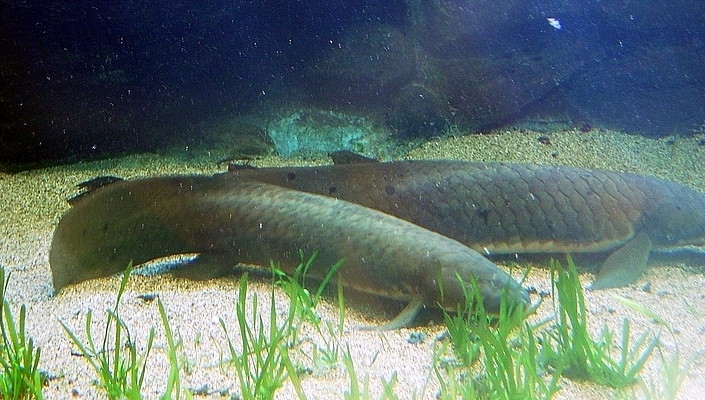The word barracuda immediately conjures images of a sleek and powerful fish with a mouthful of dagger-like teeth. While most people associate the name with large, open-water marine predators, it is several different species of freshwater fish also carry this as their common name. The majority of these come from the genus Acestrorhynchus. Read More »
Lungfishes – the Natural History and Care of Prehistoric Fishes – Part 2
 Hello, Frank Indiviglio here. Capable of surviving up to 4 years without food and water and unchanged since the time of the dinosaurs – Lungfish facts read like fiction. Please see Part 1 of this article for information on the natural history of African, Australian and South American Lungfishes. Today we’ll review their care in the aquarium.
Hello, Frank Indiviglio here. Capable of surviving up to 4 years without food and water and unchanged since the time of the dinosaurs – Lungfish facts read like fiction. Please see Part 1 of this article for information on the natural history of African, Australian and South American Lungfishes. Today we’ll review their care in the aquarium.
Lungfishes in the Aquarium
The West African Lungfish (Protopterus annectans annectans) is the species most commonly available in the trade. It and the other African Lungfishes make excellent captives if you can provide the huge aquariums they require; longevities commonly exceed 30 years. Read More »
Done With Dovii, On to the Next Cichlid Breeding Venture – Cuban Cichlids

So, now I have to figure what I should try to breed next! Several things came to mind immediately; Grammodes I’ve already bred, Argentia I’ve kept but never bred, and then there were the the Cuban Cichlids (Nandopsis tetracanthus). These medium-sized, powerhouse fish attain lenghts of up to 14 inches. They are very striking fish, both male and female are monochromatic, that is, they both sport a black and white pattern.
I was able to trade my rotten male dovii on 4 1.5 inch fish. They all went into the 40 breeder and have so far adapted really well, they were already eating an hour after being put into their new home. The following day I did a head count and was glad to see all four fish still kicking, as everything I’ve read says they are highly aggressive towards each other. Let me tell you it is so true!
They have set up the pecking order already, though they haven’t inflicted too much damage on each other yet. To break up the tension in the tank, I also introduced a Chromidotilapia sp. individual from West Africa. The little Cubans quickly went over to check out the new fish, but the dominant male was smart not to attack, since it was 2.5 times
his size. By the looks of things (if I go by size) I may have two pairs!
They feed very well. The dominant male will pig out so much his belly distends, almost to the point that I have to be careful to limit his intake…he sometimes looks as if he’s about to explode. My bet is that he will grow very quickly. These guys take everything from flakes to sinking pellets, as they get larger I will also feed them nightcrawlers and red worms. I wish that Dovii hadn’t killed his mate…he is a beautiful boy, but I couldn’t stand to look at hm after that carnage. It happens when you keep these crazy fish. So I’m hoping to have my first batch of Cuban Cichlid eggs in about 6 months from now…until then wish me luck!
Look forward to updating you on the situation!
Jose
Lungfishes – the Natural History and Care of Prehistoric Fishes – Part 1
 Hello, Frank Indiviglio here. I find it quite easy to imagine a Lungfish-like creature pulling itself from an ancient sea, setting off on land and, in the process, changing the course of life on earth. Indeed, paleontologists believe that a fish very much like today’s Australian Lungfish (Neoceratodus fosteri) pulled off just such a feat during the Devonian Period, some 160 million years ago, and in doing so set the stage for the evolution of all terrestrial vertebrates that followed (talk about “leaving your mark”!). Read More »
Hello, Frank Indiviglio here. I find it quite easy to imagine a Lungfish-like creature pulling itself from an ancient sea, setting off on land and, in the process, changing the course of life on earth. Indeed, paleontologists believe that a fish very much like today’s Australian Lungfish (Neoceratodus fosteri) pulled off just such a feat during the Devonian Period, some 160 million years ago, and in doing so set the stage for the evolution of all terrestrial vertebrates that followed (talk about “leaving your mark”!). Read More »
What Is It and Why Do I Need It, Part 1 – Activated Carbon
There are some products that you can find in every store that sells aquarium supplies and that every aquarist has purchased at some point or another, no matter how long they’ve been in the hobby or what type of aquarium they’ve had. Out of those stand-bys, how many of them do you really need, and do you know what they do (or do not) do for your aquarium? One of the most wide-spread of these “necessities” is activated carbon. Read More »
 That Fish Blog – Aquarium Advice and Information
That Fish Blog – Aquarium Advice and Information
